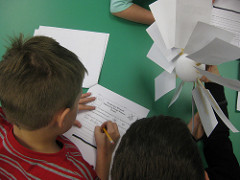Inventing inventors
By Mary Bigelow
Posted on 2017-07-06
 I’m looking for ideas to integrate physical science and social studies at the middle school level. — E., New Jersey
I’m looking for ideas to integrate physical science and social studies at the middle school level. — E., New Jersey
Inventions and inventors could be an interesting context to explore the connections between science, engineering, technology, history, and economics.
A social studies colleague framed a unit around two questions: Why do we invent or innovate? How do some inventions and innovations change society? The unit started with a discussion and demonstrations of 19th century communications technologies (telegraph and telephone), and students compared them with today’s cell phones and texting (which the students readily identified with). The students then investigated how the technology of the Industrial Revolution sparked changes that transformed the United States from an agricultural to an industrial economy, from a rural to an urban society.
To connect with physical science, topics such as mechanical forces and simple machines, motion, electricity and magnetism, and light and sound waves could be investigated in the context of inventions and technology and their impact on society. Students could engage in building projects, tinkering with things to see how they work, designing solutions to problems, and working with robotics, computers, and other electronics. Increasingly common “makerspaces” in schools and libraries provide students with the resources to collaborate, design, and create solutions.
As a culminating project, students could become inventors themselves—identifying a problem, designing and testing an invention to solve it, and marketing their invention to others, explaining the possible impact on the users. NSTA journals have articles showing young classroom inventors and “invention conventions.” (This Resource Collection has some of these articles and other online resources).
In the context of science, technology, engineering, arts, and mathematics STEM/STEAM education and the engineering focus of the NGSSNext Generation Science Standards, students should understand and have experiences with the processes of inventing and innovating, addressing the question “How do we invent inventors?”
Photo: http://tinyurl.com/jy83oqq
Disclaimer: The views expressed in this blog post are those of the author(s) and do not necessarily reflect the official position of the National Science Teaching Association (NSTA).


